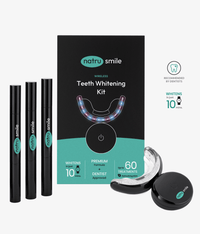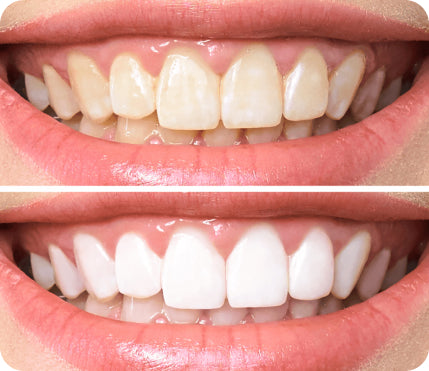
All products are certified by dental expert Dr. Greg Grillo
A good set of healthy teeth is essential. Teeth help us chew, talk, and (most importantly) give our friends a hearty smile. One aspect of a healthy mouth is the number of teeth.
But what is the correct number of teeth? Also, are there cases where we can have the wrong number? Also, how does this number change as we grow up?
This article will use proven facts to show you what counts as normal. We'll also review how this changes depending on your age and potential conditions.
How Many Teeth Do We Have?
The average adult mouth has a total of 32 teeth. This breaks down to an even number of teeth for the top and bottom: 16.
Our teeth are broken into four categories: incisors, canines, premolars, molars, and wisdom teeth. Here's how that looks:
- Incisors: These are your four front teeth on the top and bottom of your mouth, making up eight of your teeth. Incisors are built to help you hold and cut food for easier consumption.
- Canines: These make up two of the teeth to the side of the incisors, making up four of your teeth. They are called "canines" because they resemble canine teeth, making it easier to grip your food.
- Molars: There are 12 total molars on the top and bottom of your teeth. These molars are broader teeth, making it easier to grind down your food before you swallow it. The third set of molars in the mouth are your wisdom teeth, often removed.
- Premolars: There are eight premolars in your mouth, identified by the longer cusps as the ends of your teeth. You might also know them as bicuspids. They transition your teeth from gripping to grinding.
Despite the evidence, there is a preconceived notion that we have 36 teeth. Below, you'll find out where that comes from.
Do Humans Have 32 Or 36 Teeth?
Except for some rare conditions, humans will typically have 32 teeth. The alternative amount, 36, comes from early evolution.
As humans evolved, so did the shape of our heads. Specifically, as our brains grew, so did the need for a different facial structure. This facial structure had less room for teeth.
Evidence of this can be seen in the removal of our wisdom teeth. The wisdom teeth are often removed because they get trapped in our jaw. But despite their removal, adults can function with fewer teeth, having no loss in their quality of life.
As an alternative perspective, have you ever bitten into a raw steak? It requires a lot more jaw force and effort to get through. With more teeth, you can get more leverage.
But because most humans like to cook their meals, they don't need the extra teeth. Eating a tender, juicy steak takes less effort (and is far more delicious).
How Many Teeth Do Adults Have Without Wisdom Teeth?
Without wisdom teeth, our mouths only have 28 total teeth. Four wisdom teeth (two on top and two on the bottom) take away from our typical 32.
So do all adults need their wisdom teeth removed? The short answer is no. Some adults can live full, happy lives without needing to remove these teeth.
Your wisdom teeth only need to be removed in cases where they cause issues. Here are some common instances in which you see the removal of wisdom teeth:
- Impacted teeth: When a tooth is impacted, it doesn't have room to grow. Wisdom teeth are most likely to suffer from this, as they end up stuck in the back of your mouth.
- Damage to the mouth: When left alone, wisdom teeth try to force their way through, damaging your jaw and other teeth. In some scenarios, cysts can form around these teeth, causing potential nerve damage.
- Inflamed gums: The forced growth of your wisdom teeth might cause your gums to swell. This makes them more challenging to clean.
- Cavities: The swollen gums become harder to clean, which increases the number of bacteria, causing cavities to form.
- Sinuses: In some cases, wisdom teeth have been linked to sinus congestion, pressure, or pain.
How Many Teeth Does A Child Have?
Typically, a child will have 20 teeth by the time they reach three. This number can vary depending on medical conditions and their development stage.
Below, you'll see a breakdown of different ages and some expected tooth counts:
- Six to twelve months: Two to eight teeth
- One to three years: Eight to twenty teeth (at younger ages, teeth count varies heavily)
- Three to five years: 20 baby teeth
- Five to nine: 16 to 20 teeth (a mix of adult teeth and baby teeth)
- Nine to twelve: 28 teeth (their wisdom teeth haven't come in at this stage)
Despite children constantly losing and gaining teeth from three to twelve, it's essential to practice good oral hygiene. Having bad oral hygiene during youth can cause issues later in life. It also helps establish their lifelong pursuit of maintaining a healthy smile.
Good teeth brushing includes flossing, brushing, and using mouthwash. Be sure to pick up child-friendly products that lack the harshness of adult alternatives.
To encourage these habits, set yourself up for success by including teeth brushing as part of your nightly routine. Do it with them, and take the time to show them good habits.
If you want whiter teeth, it all starts with good habits. At this age, there are fewer in-office whitening options available.
How Many Teeth Do Teens Have?
Teens are on the cusp of adulthood, meaning their teeth aren't too far behind. At 13, some might still be developing, leaving them with 28 teeth. But by 14, most teens have a complete set of 32 permanent teeth.
Developmental stages vary heavily in teenagers. One teenager might have a completely different experience than the other. So, consult a medical professional if you are worried about their teeth not coming in fast enough.
Teenagers might also decide to remove their wisdom teeth at this stage. Wisdom teeth can become a problem at any stage but are most likely to start with issues when they first form. It isn't uncommon for teenagers to have 28 teeth when reaching adulthood.
How Many Teeth Do Humans Have On Top?
Humans have 16 teeth on the top of their mouths. This number might be 14 teeth if you've had your wisdom teeth removed.
The top teeth also have the same function of teeth as the bottom. You have incisors, canines, molars, and premolars for cutting and grinding through food.
Top teeth get more attention than bottom teeth because of their visibility. After all, when you smile, you can use your lip to naturally cover the bottom teeth, a luxury that the top teeth don't have.
This is why if you choose to get rid of yellow teeth, the top teeth might take priority.
It is also common for braces to only appear on your top teeth. These teeth are the most visible, and many have pride in their beautiful smiles.
How Many Baby Teeth Do Humans Have?
Newborn babies have a set of 20 milk teeth, otherwise known as deciduous teeth, that develop during the embryonic stage.
These teeth start to come in by six months, cutting through the gums. This is a very unpleasant time for babies and parents alike.
The types of teeth that come first are often the most useful. Babies start with the central incisors and eventually grow molars (most helpful in biting their solid food), reaching their first 20 teeth. Their lifelong primary teeth will eventually replace these.
Despite having fewer teeth, you can brush your baby's teeth. Starting at birth, you can use a clean, damp washcloth or gentle brush to wipe their gums clean.
When the teeth start to break through, you should use a softer baby toothbrush to take care of this. Harder adult toothbrushes aren't appropriate for taking care of this.
How Many Teeth Do Humans Have On The Bottom?
Like the top teeth, you have 16 bottom teeth without removing any. If you've gotten rid of your invasive wisdom teeth, you'll have 14 teeth.
Like the top teeth, the bottom teeth have the same types of teeth. These include incisors, canines, molars, and premolars.
The bottom teeth tend to get less attention because they can be hidden behind the lip. After all, if you put on braces or use an at-home teeth whitening kit, you might prefer to focus on what's more visible.
Conditions That Affect The Number Of Teeth
Beyond developmental stages, a few medical conditions can impact the number of teeth you have. Below, we go through those conditions for your consideration.
Tooth Loss
Tooth loss can occur from a variety of different factors. However, it more often impacts older, poorer adults who are also cigarette smokers. According to the CDC, these groups are three times more likely to lose their teeth.
Tooth loss isn't considered severe until they have eight or fewer teeth. In these cases, it affects their ability to eat some foods (like meat or fruit).
Tooth loss is often caused by poor oral health, leading to gum disease and other conditions. You can also lose your teeth as a result of a significant injury.
Tooth Decay
The stage before tooth loss is decay, which comes from some medical conditions. Often, tooth decay is a result of dental health issues.
To improve your smile, addressing tooth decay starts with a good care routine. Regular toothbrushing, flossing, and use of mouthwash can help. However, get a professional cleaning every six months to catch decay before it becomes a problem.
Ectodermal Dysplasia
Ectodermal Dysplasia (ED) is a disorder that impacts your skin, hair, nails, sweat glands, and teeth. It primarily affects children, causing abnormal growth in these (and more) areas.
This condition is often found during the development stages of childhood. It comes from a genetic defect and has no cure, but multiple treatment options.
The most common form is X-Linked ED, leading to several missing or unusually shaped teeth. Other side effects might be an inability to sweat, abnormal fingernails or toenails, or abnormally thin hair.
Gastrointestinal Reflux
Gastrointestinal Reflux Disease is when your stomach acid repeatedly flows up from your stomach. This causes acid reflux, which can lead to teeth erosion.
Many studies have shown that patients suffering from this are at high risk of dental erosion. Despite the tough outer enamel, your tooth aren't built to handle this acid.
Wrapping Up
Through a bit of research, we can confidently say that adults have 32 teeth before removing wisdom teeth and 28 teeth after their removal. This number varies depending on various health-related conditions that affect the bottom.
Concerning long-term development, babies start with 20 milk teeth. These teeth will come through the gums individually, eventually exposing themselves.
Children might appear to have eight to 16 teeth during childhood as they replace those baby teeth. As they grow older and reach their teenage years, their teeth reach 28. Not long into this teenage stage, that count goes up to 32.
Given how everyone develops differently, the teeth count of children can vary. But adults are way more predictable when it comes to counting teeth.










